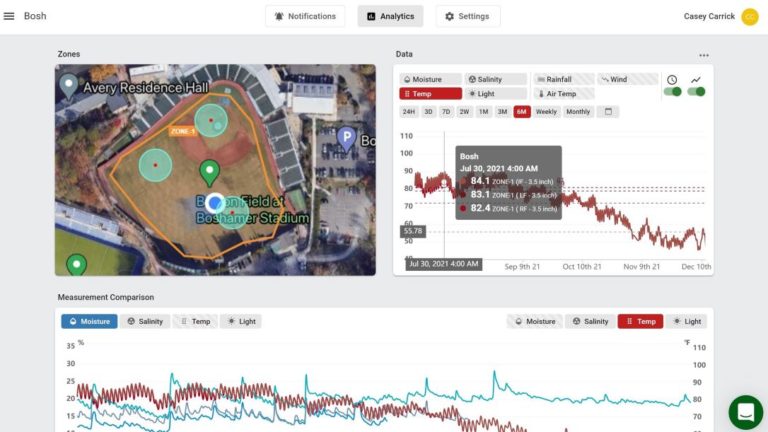By Casey Carrick, CSFM
Soil sensors? I’m good. I know my soil moisture. I know when soil temperatures are dropping. I know when to apply pre-emergent.
Those are thoughts that came to mind when someone introduced the idea of a soil sensor to me. We’ve been maintaining great playing surfaces for a long time without them, so why spend the money on them now?
Well, like everything else, the technology in soil sensors has drastically improved during the last 10 years or so. As sports field managers, we’re always monitoring pH levels, CEC, nutrient deficiencies, and everything that a simple soil test tells us. Why wouldn’t we take it a step further and start looking at moisture, temperature, and salinity in real-time data?
It does start to get a little overwhelming when you look at the options for soil sensors. Let’s start with the basics – there are two different types, permanent in-ground sensors, and portable sensors.
Permanent sensors are buried underground and don’t have to be moved. They are great for monitoring multiple fields at once, provide real-time data to a phone or computer, and multiple users can see the data. The downside to these is you must dig them up to move or replace, they only monitor the area in which they are installed, and usually multiple sensors are required for each field.
Handheld sensors stay above ground, and they are used daily or as needed to collect data. You can easily check different areas on a field, or multiple fields, with the same type data recording and monitoring as the in-ground sensors. The downside to these is someone must be “on site” to physically take the measurements, and it can be time consuming to do multiple fields.
Whether you choose an in-ground or handheld sensor, you’re able to collect the same type of data. Most sensors monitor and collect soil temperature, moisture, and electrical conductivity (EC).
Sensors measure moisture in volumetric water content (VWC) or essentially the percentage of water in the soil. Soil sensors can help determine the permanent wilting point and field capacity of a field – thus helping us irrigate with more accuracy and efficiency. Improved irrigation practices will help to provide a more consistent playing surface, save water and money, and increase the overall health of the plant.
Whether you’re managing a cool-season grass or a warm-season grass, knowing your soil temperature is key to having a quality playing surface. Soil temperature dictates a lot of the decisions we make as sports field managers as far as overseeding, pre-emergent, and fungicide applications. We’re all aware of when it’s time to overseed in the fall because it is getting cooler, or when our warm-season grasses are greening up in the spring and it’s time to apply pre-emergent. Using a soil sensor to monitor temperatures won’t reinvent the wheel when it comes to these things, but it could help us make a more educated decision and time certain applications out at the correct time.
Casey Carrick, CSFM, is director of athletic grounds and turf management at the University of North Carolina.


